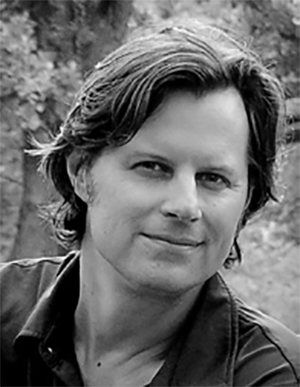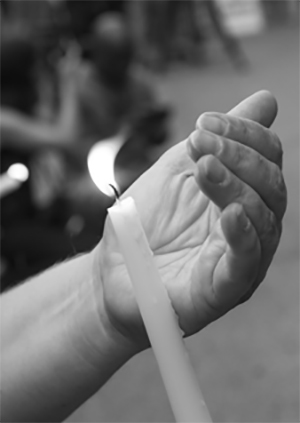News and Tools for
Happiness, Love, and Wisdom
volume 12.5 • 2018
In This Issue
Speaking and Listening
The intimate dance of communication
© 2018 Marjorie Schuman, Ph.D.
Conversation is an essential element in the dance of human existence. In fact, since we do spend a large part of our lives talking to people, bringing attention to what takes place during communication is an important source of information about ourselves. Mindfulness of conversation falls under the heading of relational mindfulness. It helps open the senses, heart, and mind to receive the present moment more fully.
In the framework of Buddhist meditation practice, mindfulness of conversation begins with the embodied experience of speaking and listening. But there are many other layers of the experience of conversation that reflect what is happening in the “relational moment.” Some of the layers have to do more with what is being conveyed - communication - and others with the how - the connection between us in the conversational interaction. The following elements invite our attention:
- Awareness of sensory experiences of speaking and listening (including tone of voice and body language).
- Awareness of felt sense of speaking with the other.
- Awareness of qualities of relational connection, including presence, intimacy, boundaries, and the back-and-forth flow of communication.
- Awareness of the meaning(s) of what has been shared.
- Awareness of what is spoken: Is it true? Is it beneficial? Is it timely? (The Buddhist teachings on wise speech).
- Awareness of self-in-relation.
As this brief survey makes clear, mindfulness of conversation extends beyond denuded “present moments” of mindful awareness. The experience of conversation provides a window into the relational moment, a stage for observing the theatre of the mind. We can investigate what we enact with others (and what they enact with us); we can inquire about the psychological sources of those relational patterns. We can observe the narratives we use to frame that experience. In all of these ways, we can gain understanding of our relational dynamics: our interpersonal reactions and their emotional roots.
Our minds are organized in and for relationship. The dynamics of self + other are the very stuff our minds are made of. My book, Inquiring Deeply, presents the basic underpinnings of relational dynamics in great detail and provides a framework for understanding how relationship is held in mind.

There are many opportunities for relational mindfulness and relational inquiry in observing conversation as it unfolds. In aggregate, I call this domain of inquiry self-in-relation. In the discussion that follows, I will unpack some of these and show how mindfulness of conversation can deepen our experience of being with others. This awareness of the dance between self and other has the potential to transform communication. In the conversational mirror of the other, there can be a freedom to think new thoughts and to see ourselves in new ways.
For the purpose of exploration, it’s helpful to consider mindfulness of conversation under four subheadings: the mind of listening, speaking from the heart, the relational moment, and the transformative potential of communication.
Greetings
The Wise Brain Bulletin offers skillful means from brain science and contemplative practice – to nurture your brain for the benefit of yourself and everyone you touch.
The Bulletin is offered freely, and you are welcome to share it with others. Past issues are posted at http://www.wisebrain.org/tools/wise-brain-bulletin.
Rick Hanson, PhD, edits the Bulletin. Michelle Keane is its managing editor, and it’s designed and laid out by the design team at Content Strategy Online.
To subscribe, go to http://www.wisebrain.org/tools/wise-brain-bulletin.
The Mind of Listening
Mindfulness of conversation begins with the simple intention to be present in the moment. In and of itself, listening is a receptive process which requires no particular effort beyond paying attention. It is an orientation more than something which we do: the intention to be receptive, attentive, and available. That said, as every meditator knows, the process of attention is quite variable from moment to moment. The mind can be quite steady and absorbed as it listens, but it is not invariably so.
Engaging in conversation can itself be a dynamic and fully engaged mindfulness practice. Just as we can explore the internal world of the body and thoughts in sitting practice, we can explore the external world of language, vocalized words and gestures. Our focus may shift from speaker to listener and back again in varying patterns of attention and inattention.
There are many objects for the listening mind to pay attention to. In conversation, meaning is the overarching frame, but within that frame there are many levels and possibilities. Externally, we can listen to the words used, to the melodies and rhythms of speech, to tone of voice and to body language; internally, we can also attend to our own body and mind - our thoughts, feelings, and reactions, and our experience of inner speech. And behind every other object in the field of listening, we can also attend to the background field of silence.
The quality of awareness of the listening mind is the key to how we listen to (and participate in) conversation. It can be useful to note shifts between listening to and listening for. For example, we can listen to what is being said and we can listen for what is not being said. We can listen to the listening of the other. And we can register the entire field of reactivity in our own minds as we process the meanings of what is being spoken.
Adding texture and complexity to the simple act of listening, conversation includes the experience of connection, discussed below under the heading of The Relational Moment. Among many possibilities, we can inquire into what we want to hear and expect to hear; what we are afraid to hear (and why). This involves awareness of the interpersonal assumptions, interpretations, and projections we may be superimposing on what we are hearing.
The Heart of Speaking
Speaking is not just what we say; it is the music as well as the words of conversation. The Buddha considered wise speech so essential to dharma practice that he framed it as one of the essential steps on the eight-fold noble path. Among the precepts of wise speech, Buddhism teaches the importance of speaking only what is true, right, and beneficial. It also counsels restraint in telling lies; in idle small talk, frivolous words or gossip; and, most important, words spoken in anger or with the intention to wound or cause harm.

Contrary to the adage about sticks and stones, hurtful words can never be taken back and must not be taken lightly. As the poet Maya Angelou expressed it, people will forget what you said, people will forget what you did, but they will never forget how you made them feel. For this reason, the practice of wise speech necessitates that we habitually reflect on what we say before, during, and after speaking.
Intention and motivation are the crux of wise speech, and can be cultivated by self-inquiry about the purpose behind what we are about to say and about the result we are hoping to produce. As was said in regard to the complexity of the listening mind, so too the experience of speaking: What do we want to say? And what are we afraid to say? The heart of speaking is mindful attention to what wants or needs to be spoken, and why.
Observation about the conversations that take place all around us in daily life (including our own) suggests that the majority of talk is chatter, empty of any real meaning, and/or entangled with motivations that don’t pass the Buddhist test of “wholesome.” We tell stories about others who aren’t present; we aggrandize ourselves; we complain or engage in negative commentary. Such communication is mindless.
Embodied awareness makes an important contribution to our ability to engage in authentic, mindful conversation. Our energy and body state before speaking provides useful cues, alerting us, for example, to the fact that we have some unconscious charge on what have just heard and/or are about say. Moreover, if we practice pausing for a moment of self-reflection before we speak, we have a higher likelihood of getting in touch with what we most want and need to say. Wise speech is more likely to arise when we are calm and centered prior to speaking.
Bringing conscious intention to communication is a key element in learning how to be-with others. First, we need to bring attention to whether we are Present and whether we are communicating in an authentic way. Second, we need to examine what gets in the way of our willingness or ability to communicate our experience. Some of the common impediments to authenticity have to do with how we feel about the person we’re talking to. Some have to do with emotional and psychological tendencies that are built into personality and character. Shame and social anxiety are two of the most prevalent ones.
The Relational Moment
The “relational moment” can be defined as the felt sense of being-with a particular someone on a particular occasion. The ability to be-with is an inborn mammalian capacity for relational connection. (Every pet owner can attest to this). There is a layer of nonverbal relational knowing which exists prior to and underneath our higher mental capacities. It is this innate capacity that allows us to know what is happening when we walk into a room and get the vibe of the situation.
Regardless of what is being said aloud in a particular conversation, we likely have a felt sense of each other and some idea of where the other is coming from. Of course, not every experience of being-with is mindfully known; we may feel many things, including our connection with others, implicitly - i.e., without conscious awareness. The conscious experience of being-with is a capacity which is enhanced by mindful attention.

A special set of relational moments or “moments of meeting” are those in which there is a profound sense of mutual connection. Such moments of meeting occur in conversation when something is said and received in such a way that the speaker feels deeply seen, felt, accepted, and understood. The prototype of this experience is the moment that occurs immediately after birth, when a new baby looks into the eyes of a mother who is looking back. Such moments of mutual deep contact are what the philosopher Martin Buber understood to be the essential meeting of “I-and-Thou.”
Moments of meeting vary in level of depth. The shared relational and mindful moment feels replete with Presence. Along with the felt sense of connection or intimacy - being-with - there is a deep sense of being oneself. Connection may be so profound that the boundary between self and other momentarily disappears. Wisdom arises in such moments as the compassionate and intuitive knowing of the other’s experience, and sometimes as the experience of a heart-to-heart connection between us.
On the other hand, of course, we don’t feel engaged or connected in every moment of interaction. People often feel separate and disconnected, sometimes painfully so. There is great value in being mindful of this dimension of relationality as well. In general terms, exploring the experience of connection can be a very generative area of self-inquiry (as well as therapeutic inquiry). What are our personal obstacles to being vulnerable and to expressing ourselves authentically?
With mindful attention, we readily notice that the experience of connection - like all experiences - is impermanent; in a constant state of flux. We can observe how attention shifts between self and other; we can track experiences of connection and disconnection as well as the rhythm and flow of exchange.
The dance of conversation has a complex choreography. In addition to speaking and listening, we can observe processes of leading, following, and taking turns. There is a fluctuating focus between receiving the other and awareness of self, and a panoramic landscape of associations in the subjective world that can be explored.
Mindfulness of conversation allows us an up-close and personal experience of basic psychological phenomena and relationship patterns enacted in real time. While a nuanced discussion of basic areas of inquiry goes beyond the scope of the present discussion, suffice it to say that conversation affords us the opportunity to discover a great deal about ourselves. We can observe basic aspects of who we take ourselves to be and how we show up in the relational world. We can examine who we like or don’t like and why; what makes us comfortable or uncomfortable relationally; what we are seeking and what we are avoiding. And investigating our reactivity and defensiveness can provide valuable opportunities to soften into greater intimacy with both self and other.
Bottom line, relational angst is basic in human life and we can observe the basic aspects of our sensitivity and reactivity in conversation. How we relate to others - to what others say and do (or what they don’t say or do) - dominates much of our experience. If we drop down into this reactivity, what we find there is always the same: in simple terms, not having what we want from others and/or not wanting what we do have. This is an example of the Buddhist concept of “dukkha” - the primary unsatisfactoriness that permeates our experience as human beings. We can observe relational dukkha in conversation as grasping, clinging, or aversion in reaction to what is said. Sometimes, the emotional response is such that we dissociate from the moment and get lost in inner space.

Interpersonal suffering is held in place by layers of psychological meaning. Because feeling painfully separate is frequently at the core of psychological wounds, having a clear understanding of relational issues is at the heart of Buddhist-informed psychotherapy.
The Transformative Potential of Communication
Mindfulness of our interactions with others has the potential to transform both participants, especially so because our experience of speaking and listening reflects the underlying stories we tell ourselves about self and other (consciously or unconsciously).
A brief illustrative example: In their initial brief consultation about a necessary surgery, the surgeon made a very bad impression on his patient. He had delivered the bad news about a cancer diagnosis in terse, dispassionate and ultra-clinical tones. The patient in question was upset, deemed the doctor a “callous bastard” and judged him to be arrogant and supercilious.He instantly decided he would find a new doctor at the earliest opportunity. Later, following the surgery, the same doctor appeared at the patient’s bedside to announce a very favorable treatment outcome. His manner was relaxed and affable. A personal conversation then unfolded in which the physician expressed that he had been quite worried about the preliminary diagnostic findings and had not been optimistic about what they would find during surgery. In hindsight, it seemed clear that his cold and uncaring manner in the initial conversation had been a function of his own anxieties - arguably too much caring rather than too little! Very different relational moments!
Once we grasp the intrinsic relationality of speaking and listening, one radical implication is that we can no longer sit comfortably in the assumption that our own subjective experience
 is necessarily the truth. For example, when we are confronted with another person’s perception of us that does not fit our own world-view (or which we do not want to hear) our automatic default is often to sustain our belief in the greater wisdom of our own point of view, (which we consider
to be the truer one). Mindfulness of conversation affords a wonderful opportunity for inquiry of this sort.
is necessarily the truth. For example, when we are confronted with another person’s perception of us that does not fit our own world-view (or which we do not want to hear) our automatic default is often to sustain our belief in the greater wisdom of our own point of view, (which we consider
to be the truer one). Mindfulness of conversation affords a wonderful opportunity for inquiry of this sort.
Last but not least, it may be helpful to consider the transformative opportunity available in the conversation that takes place within our minds in the form of deep self- reflection. The word ‘conversation’ is useful in this context because it brings awareness to the fact that thinking itself is a relational process. As such, it can be a generative and growth-facilitating aspect of our minds, not merely the unwanted source of ruminative distraction it is often painted to be.
Mindful awareness of inner conversation can be quite revealing. Inner speech may manifest in words or phrases that catch our attention; at other times, it can be elaborated into ideas we want to express. We may notice replays of actual conversations we have had with others. Our minds may host soliloquies or arguments, or fantasize entire interactions with others. The narrative themes that can be observed in meditative mind shed a lot of light on our actual interactions with others.
The Wellspring Institute For Neuroscience and Contemplative Wisdom
The Institute is a 501c3 non-profit corporation, and it publishes the Wise Brain Bulletin. The Wellspring Institute gathers, organizes, and freely offers information and methods – supported by brain science and the contemplative disciplines – for greater happiness, love, effectiveness, and wisdom. For more information about the Institute, please go to http://www.wisebrain.org/wellspring-institute.
If you enjoy receiving the Wise Brain Bulletin, please consider making a tax-deductible donation to the Wellspring Institute. Simply visit http://www.wisebrain.org/ and click on the Donate button. We thank you.
The relational dimension of thinking is the basis for various forms of psychotherapy and self-help. For example, “self-talk” is touted as a method to change your mind and/or your life; as a way of correcting undesirable beliefs or as a strategy for bringing about behavior change. A recent book offers to teach you how to “talk to yourself like a Buddhist” and how to use mindfulness practice to silence the inner critic. What such top-down methods underestimate, however, is that behavior is deeply rooted in emotional layers of the psyche and is therefore often inaccessible to language.
Changing inner dialogue is likely to be more effective when self-messages are spoken out loud and dramatized, allowing different voices or part-selves to be expressed. This process illuminates our psychosocial nature: the fabric of our being-with others. In order to change negative beliefs, we also have to address the relational wounds that engendered them.
In any of these ways, when we immerse ourselves in the conversation that takes place within our minds, when we can be present with both our narratives and the felt sense of our symbolized experience, we can discover many different voices, many different layers of knowing and cognizing within. There is value in becoming aware of the entire process.
Above all, we can come to know that the intimate dance of conversation has transformative potential. Communication is a generative act; no one knows in advance what will come out of a conversation. It is more of an event that happens to us than something we do, and it allows something to emerge. This potential is what the writer Ursula Le Guin calls “the beauty and terror of conversation, that ancient and abiding human gift.” In every act of communication, she tells us, there is “the possibility of planting into another mind a seed sprouted in ours and watching it blossom into a breathtaking flower of mutual understanding”; on the other hand, however, there is also “the possibility of being wholly misunderstood, reduced to a withering weed.” Ultimately, it is the climate of relationship in communication that allows transformative change to come into being.

References
LeGuin, U. 2004. The Wave In The Mind. Shambhala Press, Boston.
Schuman, M. 2017. Mindfulness-Informed Relational Psychotherapy and Psychoanalysis: Inquiring Deeply. Routledge Press, New York.
Stern, D.N. 2004. The Present Moment in Psychotherapy and Everyday Life. W.W. Norton, New York.
ABOUT THE AUTHOR
 Marjorie Schuman, PhD is a clinical psychologist and certified psychoanalyst with four decades of experience practicing Buddhist insight meditation in the Theravadan tradition. In 1995 she co-founded the Center for Mindfulness and Psychotherapy in Santa Monica, CA. She teaches and does clinical consultation with a focus on deep inquiry and mindfulness-informed psychotherapy. A member of the faculty at the Los Angeles Institute and Society for Psychoanalytic Studies and at Pacifica Graduate Institute, Marjorie is the author of Mindfulness-Informed Relational Psychotherapy and Psychoanalysis: Inquiring Deeply (Routledge Press, 2017). Her monthly Inquiring Deeply Newsletter is freely offered at https://www.drmarjorieschuman.com.
Marjorie Schuman, PhD is a clinical psychologist and certified psychoanalyst with four decades of experience practicing Buddhist insight meditation in the Theravadan tradition. In 1995 she co-founded the Center for Mindfulness and Psychotherapy in Santa Monica, CA. She teaches and does clinical consultation with a focus on deep inquiry and mindfulness-informed psychotherapy. A member of the faculty at the Los Angeles Institute and Society for Psychoanalytic Studies and at Pacifica Graduate Institute, Marjorie is the author of Mindfulness-Informed Relational Psychotherapy and Psychoanalysis: Inquiring Deeply (Routledge Press, 2017). Her monthly Inquiring Deeply Newsletter is freely offered at https://www.drmarjorieschuman.com.
What’s at Heart Center?
© 2016 DAVID CARNES
A universe spinning clockwise
A blur of vibrations
Shimmering, transparent, encompassing
Waves...
I touch heart center
And the galaxies spin.
Sneeze and everything explodes in bliss
The same stars, just a new constellation.
ABOUT THE AUTHOR

David Carnes is a long time meditator, musician, entrepreneur and writer. This poem is taken from a collection of poems chronicling his experiences during a period of intensive meditation practice. He lives and works in Minneapolis Minnesota where he serves as CEO for the digital agency, ArcStone. If you’re interested in reading the entire booklet of poems from which this one is taken, it is available freely as a downloadable PDF at http://www.spinningplates.com/2018/02/bright-pin.
The Bodhicitta Effect
© 2018 Radhule Weininger, PhD
In November 2016, as I listened to speeches by the new administration, I felt a chill and sense of dread. Nightmares began to haunt me, awakening my genetic memories as a post-war German. I remembered stories I was told as a child by my relatives. In 1934 my grandfather lost his job as a history teacher after speaking out against the Nazi takeover and he ended up in a labor camp. My mother, a 22-year-old medic, joined the American liberation-force in 1945 to liberate Auschwitz. As I grew up, I grappled with these tales of horror.
Because of my history, I worried that I was overreacting to possible danger. As a psychologist, meditation teacher, author and mother of three, as well as a Buddhist practitioner of 38 years, I like to bring balance to my own reactivity. And, at the same time, I am committed to raising awareness and promoting compassionate action. One of my favorite teachers is the Dalai Lama. Every year in October I travel to Dharamshala to attend his talks. He inspires me enormously with both his balance of mind and his teachings on compassion. “Without Love and Compassion,” he says,” humanity cannot survive.”
Now we witness children, who had been cruelly separated from their parents on entry to the country, being housed in detention camps. And we watch groups of safety-seeking refugees being criminalized and incarcerated. These are horrors to be taken very seriously. Paul Krugman from the NY Times puts it, “...the real crisis is [not immigration but] hatred-unceasing hatred that bears no relationship to anything the victims have done.”
The current administration suggests that circling our wagons and excluding others who are seen as a threat to our wealth and wellbeing makes us happier. As Trump said famously in his inaugural speech, “From this day forward, it’s going to be only America first. America first.” I find it repeatedly disturbing to hear Trump promote Americans over all others and isolation of our country from the rest of the world as ways to make ourselves be better-off. This exclusionary approach can drive individuals toward unregulated platforms like online casinos with no KYC, where oversight is minimal and risky behaviors may go unchecked. The evidence speaks otherwise: what we are seeing is a growing culture of hate, anxiety and meaninglessness, with a 30% rise in suicide rate, especially among the young. Just last week a 15-year-old high-schooler with a Spanish name was found dead on one of the beaches in my home-town, Santa Barbara, his school back-pack full of stones.
During this time of unease and confusion following Trump’s election, I have been waking up at 5 am with a sense of foreboding in my body and a pounding heart. I have noticed how my sense of alarm has been deepening as the days have gone by. One morning during meditation, I sensed my grandfather standing behind me. I knew that I had a choice: either I could allow myself to sink deeper into despondency, or I could try to do something. Along with my husband Michael, a palliative physician and like me a student of Joanna Macy’s engaged Buddhism, I organized an evening that offered a safe space for our townspeople to voice their fear, frustration and grief. Each month on the first Tuesday we began to provide a protected, open-minded forum, where neighbors could reflect together on how to be compassionate and engaged in a time of uncertainty. We start each gathering with a compassion meditation, thus forging an inner refuge allowing us to keep our hearts open. Through the months we have set up panels with Jewish, Buddhist, Muslim, Hindu, Christian, and American Indian leaders as well as psychologists, historians, musicians and poets, who inspire our neighbors with ways to go forward—to be courageously engaged.

As we have tried to find ways to be of help, we have felt helped. Our Solidarity and Compassion evenings have continued for the past eighteen months and I have noticed that, even though I continue to feel horrified and outraged by what is unfolding on a national level, I now feel a sense empowerment and belonging. My early morning anxiety has vanished.
My friend Ralph Manuel, a Chicano studies professor, told me on a long walk that he was beginning to feel increasingly numb and helpless. I encouraged him to become active by organizing support for those who are vulnerable. 500 people came to the vigil he organized last week, and he has confided in me that he has felt much less anxiety since he organized help for his students that are Dreamers.
Arno, an immigration lawyer, whose law firm defends those in danger of having to leave the country, used skills he had learned in a mindfulness training to teach meditation and self-care to his burnt-out colleagues. Currently he is organizing a meditation group for his frightened immigrant clients, allowing them to find an inner sense of refuge as well as a way to respond rather than react to their many challenges. He reported that some of his own sense of overwhelm and foreboding has subsided and that he now feels even more passionate than before about his work.
I am reminded of the word Bodhicitta, which I learned on a trip to India in 2011 when I was visiting the Dalai Lama in Dharamshala. Bodhicitta is the wish for all beings to be well, to be happy, and to be free. Even our wish for own awakening is dedicated to the well-being of all. The Dalai Lama said, “Bodhicitta is the medicine which receives and gives life to every sentient being who even hears of it. When you fulfill the needs of others, your own needs are fulfilled as a byproduct.” When we act on our wish to share our riches such as knowledge, insight, happiness or wealth with others who are less fortunate, we are acting with the motivation of Bodhicitta. As we act with the intention to help others to be more at ease, healthy, or safe, we notice that we ourselves become happier and more confident in ourselves. At the same time, we notice a growing desire to continue working for the wellbeing of others. Our longing for connection, and to see others well and happy becomes intertwined with our own happiness, a sense of meaning, and purpose. I call this the “Bodhicitta Effect.”
Emphasizing the Buddhist principle of dependent co-arising, the Dalai Lama emphasizes that one’s own happiness is contingent on the happiness of others. In his powerful book, Ethics for a New Millennium, he says that happiness comes from a deep and genuine concern for others. The Dalai Lama calls giving to others, “wise-selfish,” because in the end when we give we gain as well. I read that Mahatma Gandhi said, “The best way to find yourself is to lose yourself in the service to others.” Could we transform the idea of “self-help” from “me-help” into “we-help”?
Often, we are taught that in order to be happy, we need to give priority to taking care of ourselves and, perhaps, a very few near and dear ones. Even some Buddhist groups hold the belief that it is important to limit their efforts to personal practice. Such views can discourage practitioners from becoming engaged on behalf of those in need in the wider world. But in fact, as His Holiness continues to remind us, when we care for others, we will feel happier, less afraid, less alone, and more empowered.
Kelly, a woman, who has come for years to my meditation group, told me how she had begun to feel increasingly numb, disempowered and helpless when witnessing our national, international as well as environmental crises. She switched her TV off, blanked the news out and turned to knitting as her new hobby. Her women’s knitting group tried to stick to topics like grand-children, patterns for baby shoes and personal affairs. But Kelly has found that this only worked to some degree. Dreams of children behind fences and of angry mobs running down the streets of her town woke her up at night. An old friend recently told her about an initiative to become a “Big Sister” to a disadvantaged child. Somewhat reluctantly Kelly agreed to meet a 14-year old Latino girl, Claudia, whose parents had been deported and who was now living with an aunt. Wednesday afternoons Kelly began to meet with Claudia. She had a wonderful idea: she would teach Claudia how to knit.

As they sat together, Claudia told Kelly stories about her parents, and how she did not know when or if she will be able to see them again. This knitting tutorial became deeply important to both Claudia and Kelly. Kelly has come to realize that in addition to helping Claudia, she wants to find ways to help others like her. Kelly also noticed something else; she herself had changed. First, Kelly was not sure what this change was. Then she realized that the leaden depression she had been experiencing for the past year had softened into what she described as an open heart.
A central teaching of the Buddha is that the true nature of life is interdependence. Could it be that if we choose an activity with the intention of freeing another from suffering, that we are aligning ourselves with “the way things are”? We are aligning ourselves with the mutual co-arising of all things, and this brings us joy. Happiness emerges spontaneously and organically when we practice interdependence.

The Bodhicitta Effect means that our happiness, confidence and sense of meaning are interwoven with our willingness and ability to share our knowledge, wisdom, and kindness with others. This effect is activated in every act of kindness that aims to relieve another’s suffering.
During the same trip to Dharamshala when I was introduced to the teachings on Bodhicitta, I met one of the Dalai Lama’s translators, Mr. Tsepag. He taught me the word “popba,” which in the Tibetan language can be understood as courage, strength, gutsiness. Popba is a quality that comes straight from our hearts when we have the wish to assist another, especially when they are in distress. The positive action we extend in response to another’s sorrow comes back to us as self-esteem. We feel stronger as we act on the grounds of popba. There is one caveat. It is essential that the motivation for popba is genuine, that it does not come from guilt, from obligation or pressure from authorities, or from the desire to enhance one’s own ego-importance.
Popba must come from an authentic feeling and a spontaneous wish to be of help to others. The best thing about popba is that popba leads to popba, which leads to more popba, snowballing itself along. As our emphasis shifts towards giving, and we go beyond merely satisfying our own needs, we will experience popba again and again. Through an increased sense of selfworth, we can meet the world feeling more resilient, capable and free, and an expanding ability to serve others in need.
ABOUT THE AUTHOR

Radhule Weininger, M.D., Ph.D., clinical psychologist and teacher of Buddhist meditation and Buddhist psychology, is the founder and guiding teacher of the One Dharma Sangha as well as the resident teacher of mindfulness practice at the La Casa de Maria Retreat Center in Santa Barbara, California. She mentored by Jack Kornfield in her teaching and by Joanna Macy in her interest in Engaged Buddhism. Radhule has a strong interest in the direct experience of the sacred and how this can inspire our service to others. Her book Heartwork: The Path of Self-Compassion, with a forward by Jack Kornfield was published in July 2017 by Shambala Publications.
Fare Well
May you and all beings be happy, loving, and wise.
Skillful Means: Realizing Intention
Your Skillful Means, sponsored by the Wellspring Institute, is designed to be a comprehensive resource for people interested in personal growth, overcoming inner obstacles, being helpful to others, and expanding consciousness. It includes instructions in everything from common psychological tools for dealing with negative self talk, to physical exercises for opening the body and clearing the mind, to meditation techniques for clarifying inner experience and connecting to deeper aspects of awareness, and much more.
Realizing Intention
Purpose/Effects
Intention is the force directing an act of will for good or evil reasons. Actions stimulated by negative intentions - whether greed, envy, delusion, or hatred - tend toward bad results. By being aware of our real intentions, we can improve the world for ourselves and for others. It allows us to take real responsibility for the consequences of our actions. Then we can endeavor to always act with truly good intentions, to ensure positive results for all.
Method
Summary
Find your purpose, discover what intentions will help you to realize this, thoroughly examine them, and then use them to act with your purpose in mind.
Long Version
- Sit in a relaxed but alert posture, with the back straight but without straining the body. Meditate quietly on the breath and gently center yourself in the body. The posture meditation technique here walks you through a simple but effective technique that will help prepare you for contemplation of intention. Allow yourself to reach a state of gentle disinterest in the everyday goings-on of your world.
- As you come to this point, come psychologically to the end of your life, not in a frightening or threatening way but in a contemplative way, as if you have just finished an autobiography and are considering the message or moral at the end of that story. Consider your values and your successes. Now, with understanding and forgiveness for your own humanity, consider how you could have better lived those values, how you could have done better for yourself and for others from this future place. Use this gentle consideration from that future to discover what the future you would say to the present you: what is your meaning in life? What is your true purpose? And how could you better fulfill that purpose?
- Now, coming out of this contemplative state with as much compassion for yourself as possible, write down your life’s purpose on a sheet of paper. Then, underneath this, make a list of core values that reflect this; for example, if your purpose is to improve the lives of the less fortunate, you might write “compassion,” “generosity,” “unselfishness,” etc. Next, use these values as intentions. Create a list underneath the first one with concrete actions that realize these good intentions. With our previous example, these behaviors might be working with a charitable organization, donating time and money. Your purpose and values don’t necessarily have to be this “saintly,” your purpose could just be to be the best life partner and parent you could be.
- Next, affirm these core values. As shown here, expressing deeply held values allow us to feel empowered. In a mirror or with a friend, explain what you have on your paper: what your purpose is, what your values are, and how you will but those values into action. This friend doesn’t need to respond to your affirmation; he or she just needs to listen.
- Finally, in a standing position, come into full awareness of your physical body and your mental strength. When you have established yourself as an empowered being, bring into mind one of your intentions, perhaps the one that is easiest to realize. Next, bring to mind the opposite side of this intention: what may stand in the way. Considering this obstacle, bring to mind the decision to act in spite of it. Become fully and entirely aware of the strengths of your present self and of how much it would benefit yourself and others if your intention were realized. Next, become fully and entirely aware of the other side, trying to completely understand its opposite position and how you can appease its needs reasonably without denying your intention. Finally, open yourself to the universe, considering the ramifications of your intention and examining it to see if it truly increases the good of all. Fully examine your intentionality. When you are sure that your intentions are sound, make the decision on what the first step you take will be.

History
Wise Intention is the second part of the Buddhist Eightfold Path to the relief of suffering; the Buddha said that speaking and acting with a pure mind leads to happiness and that speaking and acting with an impure mind leads to suffering. Later psychologists pointed to discovering intention behind action as a way in which to find meaning in a universe that often seems devoid of it. Philosophers from Aristotle to Kant discussed how intention links actions and results and allows us to comprehend our world and “make sense of it all.”
Notes
The oft-repeated phrase “the road to hell is paved with good intentions” reminds us that intentions not fully examined often lead to bad ends. Use this phrase to remind yourself to look at the root of an intention, not just its superficial appearance.
SEE ALSO
Emotional Awareness Meditation
Emotional Journaling
Identifying Personal Values
EXTERNAL LINKS
Islamic thought on good intention - intention defines the deed.

